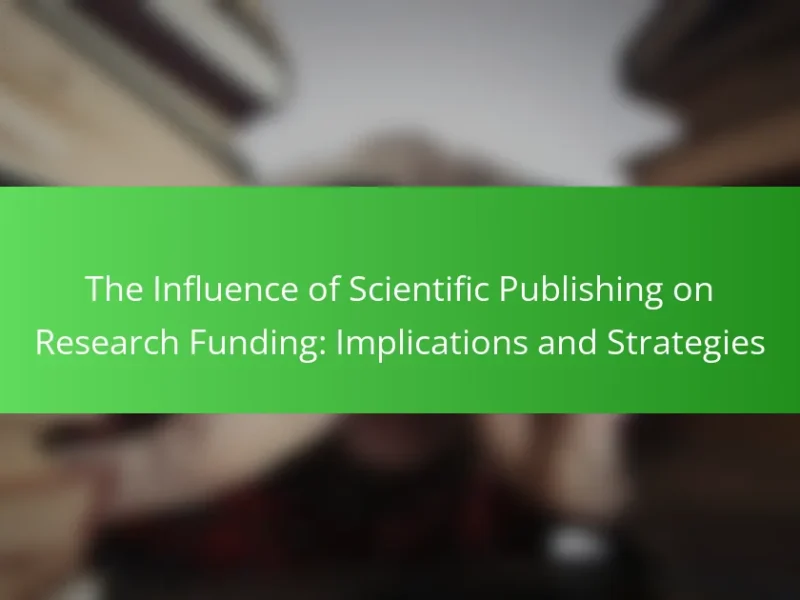The article focuses on the evolution of scientific journals, tracing their origins from the 17th century with the establishment of the first peer-reviewed journal, “Philosophical Transactions.” It highlights the expansion of scientific journals through the 19th and 20th centuries, reflecting advancements in research and technology. Current trends include an increase in open access publishing, data sharing, interdisciplinary research, and the integration of artificial intelligence in the peer review process. Future directions suggest a continued emphasis on open access, innovative peer review methods, and enhanced editorial efficiency through AI, ultimately promoting greater accessibility and transparency in scholarly communication.

What is the historical context of scientific journals?
Scientific journals originated in the 17th century as a means to disseminate research findings. The first recognized journal, “Philosophical Transactions,” was established in 1665 by the Royal Society of London. This journal set the standard for peer-reviewed publication. Over time, scientific journals expanded to cover various disciplines. The 19th century saw a proliferation of specialized journals, reflecting the growing complexity of scientific fields. By the 20th century, the number of scientific journals increased significantly, driven by advancements in research and technology. Today, thousands of journals exist, each contributing to the vast landscape of scientific knowledge. The historical context reveals the evolution from informal communication to formalized peer-reviewed platforms.
How did scientific journals originate?
Scientific journals originated in the 17th century. The first recognized scientific journal, “Philosophical Transactions,” was published in 1665 by the Royal Society of London. This journal aimed to disseminate scientific knowledge and findings to a broader audience. Other early journals followed, such as “Journal des Sçavans” in France, also established in 1665. These publications provided a platform for researchers to share their work and engage with the scientific community. The growth of scientific societies and the demand for formal communication led to the proliferation of journals. By the 19th century, the number of scientific journals increased significantly, reflecting the expansion of scientific disciplines.
What were the first scientific journals and their purposes?
The first scientific journals were “Philosophical Transactions” and “Journal des Sçavans.” “Philosophical Transactions” was established in 1665 by the Royal Society of London. Its purpose was to publish original research and facilitate communication among scientists. “Journal des Sçavans” began in the same year in France. It aimed to summarize and disseminate scholarly work across various disciplines. Both journals marked the formalization of scientific communication. They contributed to the establishment of peer review and the standardization of scientific publishing. These early journals set the foundation for modern scientific literature.
Who were the key figures in the establishment of early scientific journals?
Key figures in the establishment of early scientific journals include Joseph Addison, Richard Steele, and Henry Oldenburg. Joseph Addison and Richard Steele founded “The Spectator” in 1711, which influenced the format of later journals. Henry Oldenburg is known for establishing the “Philosophical Transactions of the Royal Society” in 1665. This journal is often regarded as the first scientific journal. Oldenburg’s work laid the foundation for the peer-review process. These figures played crucial roles in advancing scientific communication and publication practices.
What major milestones have shaped the evolution of scientific journals?
The evolution of scientific journals has been shaped by several major milestones. The establishment of the first scientific journal, “Philosophical Transactions” by the Royal Society in 1665, marked the beginning of formal scientific communication. The introduction of peer review in the 18th century enhanced the credibility of published research. The growth of specialized journals in the 19th century allowed for focused discussions within specific fields. The advent of digital publishing in the late 20th century revolutionized access to research. Open access movements in the 21st century aimed to remove financial barriers to scientific information. The rise of online databases and indexing services improved discoverability and accessibility of research articles. These milestones collectively transformed how scientific knowledge is disseminated and accessed globally.
What role did peer review play in the development of scientific journals?
Peer review established a critical quality control mechanism for scientific journals. It ensured that submitted research underwent rigorous evaluation by experts in the field. This process helped to validate findings and enhance the credibility of published work. The practice originated in the 18th century, gaining prominence with journals like “Philosophical Transactions” of the Royal Society. By the 20th century, peer review became a standard practice in most scientific publications. It contributed to the integrity of research by filtering out flawed studies. This mechanism also fostered a culture of accountability among researchers. Overall, peer review has been fundamental in shaping the reliability and reputation of scientific journals.
How did technological advancements influence the publication of scientific journals?
Technological advancements significantly influenced the publication of scientific journals by improving accessibility and dissemination. The advent of the internet allowed for rapid online publishing. This accelerated the peer review process and reduced publication times. Digital platforms enabled worldwide access to research findings. Open access models emerged, increasing the visibility of scientific work. Online databases and indexing services improved discoverability of articles. Furthermore, advancements in data management facilitated better organization of research content. These changes collectively transformed how scientific information is shared and consumed.

What are the current trends in scientific journals?
Current trends in scientific journals include an increase in open access publishing. This model allows wider access to research findings. Many journals now require data sharing and transparency. This enhances reproducibility and trust in scientific results. There is also a rise in interdisciplinary research publications. These journals address complex global challenges by integrating multiple fields. Additionally, there is a growing emphasis on publishing negative results. This trend aims to reduce publication bias. Finally, the use of artificial intelligence in peer review is emerging. AI tools assist in improving the efficiency and quality of the review process.
How are digital platforms changing the landscape of scientific publishing?
Digital platforms are transforming scientific publishing by increasing accessibility and speeding up dissemination. They allow researchers to share findings instantly with a global audience. Traditional barriers, such as subscription fees, are reduced or eliminated. Open access models enable free access to research articles. This shift promotes wider readership and collaboration among scientists. According to a 2021 study by the National Institutes of Health, open access articles receive significantly more citations than traditional publications. Digital platforms also facilitate multimedia content, enhancing the presentation of research. Moreover, they support data sharing and reproducibility, vital for scientific integrity. Overall, digital platforms are reshaping how research is published and consumed.
What are the benefits and challenges of open access publishing?
Open access publishing provides free access to research articles, promoting wider dissemination of knowledge. This model increases visibility and citation rates for authors. Research indicates that open access articles are cited up to 18% more frequently than traditional publications. It also enhances collaboration among researchers globally.
However, open access publishing faces challenges. Funding models often rely on article processing charges, which can limit access for authors without institutional support. Additionally, the proliferation of predatory journals undermines quality and trust in open access publishing. The lack of rigorous peer review in some cases raises concerns about the reliability of published research.
How do online databases and repositories affect journal visibility?
Online databases and repositories significantly enhance journal visibility. They provide a centralized platform for researchers to access scholarly articles. Increased accessibility leads to higher citation rates for published works. For instance, journals indexed in databases like PubMed or Scopus often experience greater readership. Studies show that articles in open-access repositories receive up to 50% more citations. This visibility fosters collaboration among researchers and promotes knowledge sharing. Additionally, online platforms facilitate the discovery of articles through search engines, further amplifying reach. Overall, these databases play a crucial role in disseminating research more broadly.
What role do metrics and impact factors play in scientific journals today?
Metrics and impact factors serve as critical indicators of a scientific journal’s influence and quality. They help researchers assess the significance of journals in their fields. Metrics quantify citation frequency, reflecting how often articles are referenced by other researchers. Impact factors, calculated annually, provide a numerical value representing a journal’s citation performance. High impact factors often attract more submissions and readership, enhancing a journal’s reputation. According to a 2020 study by the American Association for the Advancement of Science, journals with higher impact factors are perceived as more prestigious. This perception influences researchers’ decisions on where to publish their work. Thus, metrics and impact factors play a vital role in shaping the landscape of scientific publishing today.
How are citation metrics calculated and used in evaluating journals?
Citation metrics are calculated by analyzing the number of times articles in a journal are cited by other publications. This calculation often involves databases like Web of Science or Scopus. The most common metric, the Impact Factor, is derived from the number of citations in a specific year to articles published in the previous two years, divided by the total number of articles published in those two years.
These metrics are used to evaluate journals by providing a quantitative measure of their influence and reach within the academic community. Higher citation metrics typically indicate greater visibility and impact of the journal. They can influence researchers’ decisions on where to submit their work, as well as funding and institutional support based on perceived prestige.
Citation metrics also help in comparing journals within the same field, guiding readers and authors in selecting reputable sources. However, reliance solely on these metrics can lead to biases, as they may not fully capture the quality of research or the journal’s contributions to the field.
What are the implications of impact factors for researchers and institutions?
Impact factors significantly influence researchers and institutions by shaping publication strategies and funding opportunities. Researchers often target high-impact journals to enhance visibility and career prospects. Institutions may prioritize research output in these journals to boost their reputation and rankings. High impact factors can lead to increased citations, which further enhances a researcher’s profile. Conversely, reliance on impact factors can encourage publication bias, favoring trendy topics over innovative or niche research. This may compromise the diversity of scientific inquiry and knowledge. According to a study by the American Association for the Advancement of Science, institutions with higher average impact factors tend to attract more funding.

What are the future directions for scientific journals?
Future directions for scientific journals include increased open access and digital publishing. Open access models promote wider dissemination of research. This shift enhances visibility and citation rates for authors. Additionally, journals are adopting innovative peer review processes. These processes may include open peer review and post-publication review. Such changes aim to improve transparency and accountability in research. Furthermore, the integration of artificial intelligence is expected to streamline editorial processes. AI can assist in manuscript screening and plagiarism detection. Overall, these trends indicate a move towards more accessible and efficient scholarly communication.
How might artificial intelligence shape the future of scientific publishing?
Artificial intelligence will significantly transform scientific publishing by automating various processes. It can streamline peer review by utilizing algorithms to assess manuscript quality. AI tools can identify potential reviewers based on expertise and past publications. Additionally, AI can enhance the editing process through grammar and style checks. Machine learning algorithms can analyze citation patterns to predict article impact. Furthermore, AI-driven platforms can facilitate personalized content recommendations for researchers. These advancements lead to faster publication times and improved accessibility of research. Overall, AI is poised to revolutionize efficiency and effectiveness in scientific publishing.
What potential applications of AI could improve the peer review process?
AI can enhance the peer review process through automated manuscript screening. This application can identify potential conflicts of interest and ethical issues in submissions. AI algorithms can also assess the quality of writing and adherence to journal guidelines. These tools can streamline the review process by suggesting suitable reviewers based on expertise. Additionally, AI can analyze reviewer comments for consistency and bias. Machine learning models can predict the likelihood of acceptance based on historical data. By integrating these applications, the peer review process can become more efficient and transparent.
How could AI influence the accessibility and dissemination of research?
AI could significantly enhance the accessibility and dissemination of research. It can automate the analysis of vast datasets, making research findings more readily available. AI algorithms can categorize and summarize research papers, improving searchability. Additionally, AI-driven platforms can provide personalized recommendations based on user interests. This technology can also facilitate real-time translation, breaking down language barriers in research access. According to a study by the National Academy of Sciences, AI tools can expedite the peer review process, leading to faster publication times. Furthermore, AI can identify emerging trends and gaps in research, guiding future studies.
What trends are emerging in the collaboration between researchers and publishers?
Emerging trends in the collaboration between researchers and publishers include increased open access initiatives and data sharing. Researchers are advocating for greater transparency and accessibility of published work. Publishers are responding by offering more open access options, allowing wider dissemination of research findings. Collaborative platforms are also being developed to facilitate real-time feedback and peer review. This shift is driven by the demand for faster publication processes. Additionally, there is a growing emphasis on interdisciplinary research collaborations. Publishers are adapting by creating specialized journals that cater to these diverse fields. The integration of technology, such as AI in manuscript review, is also becoming more prevalent. These trends reflect a changing landscape in academic publishing, prioritizing collaboration and accessibility.
How are interdisciplinary approaches affecting the publication process?
Interdisciplinary approaches are transforming the publication process by fostering collaboration across diverse fields. This collaboration enhances the quality and relevance of research outputs. Researchers are increasingly combining methodologies from various disciplines. This leads to innovative perspectives and comprehensive findings. Journals are adapting by creating special issues focused on interdisciplinary topics. They are also revising submission guidelines to accommodate diverse research formats. The impact is evident in increased citation rates for interdisciplinary works. A study by the National Science Foundation found that interdisciplinary research receives more attention and funding. These changes reflect a shift towards a more integrated approach to knowledge dissemination.
What are the implications of collaborative publishing models for scientific research?
Collaborative publishing models significantly enhance scientific research by promoting open access and knowledge sharing. These models facilitate faster dissemination of research findings among scientists and practitioners. They often involve multiple authors from diverse institutions, enriching the quality of research through varied expertise. Collaborative models also increase the visibility and impact of published work, as shared platforms reach broader audiences.
Moreover, they encourage interdisciplinary collaboration, which can lead to innovative solutions for complex scientific problems. Studies show that collaborative research often results in higher citation rates, indicating greater influence within the scientific community. Additionally, these models can reduce publication costs, making research more accessible.
The shift towards collaboration reflects a broader trend in science that values teamwork and collective effort. Evidence from initiatives like the Open Science movement supports the effectiveness of these models in fostering transparency and reproducibility in research.
What best practices should researchers follow when choosing a scientific journal?
Researchers should consider several best practices when choosing a scientific journal. First, they should evaluate the journal’s scope and focus. This ensures alignment with their research topic. Second, they must review the journal’s impact factor and reputation. High-impact journals often indicate broader visibility and credibility. Third, researchers should assess the journal’s audience. Understanding who reads the journal can guide the publication’s relevance. Fourth, they should examine the journal’s peer review process. A rigorous review process enhances the quality of published work. Fifth, researchers need to consider the journal’s open access policies. Open access can increase accessibility and citations. Lastly, they should verify any publication fees. Some journals may impose high fees that could impact funding. Following these practices helps researchers select the most suitable journal for their work.
The main entity of the article is scientific journals, which have evolved significantly since their inception in the 17th century. The article examines the historical context of scientific journals, highlighting key milestones such as the establishment of the first peer-reviewed journal, “Philosophical Transactions,” and the impact of technological advancements on publishing. Current trends, including open access publishing and the integration of artificial intelligence, are analyzed, alongside future directions that emphasize collaboration and interdisciplinary research. Additionally, the article discusses best practices for researchers in selecting appropriate journals for their work.


